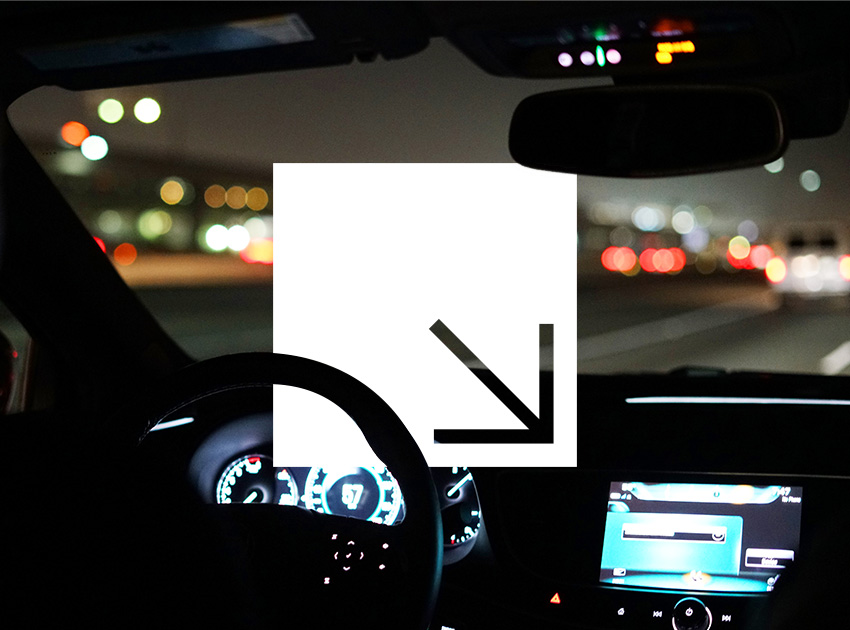Dark roads, reduced visibility, and dazzling lights are some of the factors that can make driving at night a daunting experience.
Factors such as these can mean that there is often an increase in bumps, scrapes, and collisions, with The Royal Society for the Prevention of Accidents stating that 40% of accidents happen when driving at night. This can make night driving more stressful, especially if you are using a hire car.
Plan for all eventualities with our hire car excess cover, which will give you peace of mind if any accidental damage is caused to your rental vehicle.
1. Get Enough Rest
While this may seem obvious, ensuring you are well-rested and alert is essential for safe night driving.
Tiredness can have a significant impact on your concentration, awareness, and reaction times, making you a danger to yourself and other motorists.
The road safety charity Brake advises that driving when tired is just as dangerous as drink-driving and that 10% -20% of accidents worldwide are caused by driver fatigue.
If you are going to be driving at night for an extended period of time, it is important to stop driving at the first sign of tiredness, take regular breaks, and consider booking an overnight stay if needed.
2. Use your lights correctly
Before taking to the road at night, it is important to check that your lights are all in good working order.
Visibility can be significantly reduced at night, so it is vital that other drivers can see you just as well as you can see them.
The Highway Code states that all sidelights and rear lights should be lit between sunset and sunrise, and that you must not use any lights that can dazzle other road users.
When driving at night, it is a legal requirement to use your dipped headlights.
If visibility is seriously reduced and you cannot see more than 100 metres, The Highway Code states that you must use your full beam lights and fog lights.
However, they will need to be switched off as soon as visibility improves.
3. Keep your windows and mirrors clean
Ahead of your drive, it is always a good idea to give your windows and mirrors a clean.
While they may appear to be clean already, any dirt or grease from the day will be more noticeable in the dark and may affect your ability to spot potential hazards.
It is also worth keeping a cloth in your car to wipe away any condensation that may build up on your windscreen during your drive at night.
4. Take your time
There is nothing more important than reaching your destination safe and well.
That is why it is essential that you adapt your driving style to suit the conditions, as you would when driving in snow or on ice.
By reducing your speed, increasing your follow distance, and taking your time, you will be able to anticipate potential hazards and react safely.
5. Avoid staring at oncoming headlights
It can be difficult to avoid distractions when driving on the road at night, particularly the headlights of oncoming vehicles.
The glare from other cars’ lights can temporarily reduce your vision and be disorientating.
If the glare has severely impacted your vision, it is best to gradually reduce your speed instead of coming to an abrupt halt, as this could cause a collision.
6. Watch out for pedestrians, children and wildlife
When driving at night, is it is important to consider those who are more vulnerable, as well as other road users.
If you are driving through residential areas or near a school, be sure to keep your speed low in case someone does step out onto the road.
This can also be the case when driving on country roads, where you may encounter pedestrians walking or animals darting across the road.
It is also important to keep an eye out for any cyclists. While they are advised to wear reflective clothing and have their bike lights on, this is not always the case. So, it is important that you slow down and allow them plenty of space and room.
7. Pack night-time driving essentials
It’s important to plan for all eventualities. After all, what could be worse than being stranded on the motorway at night while waiting for breakdown recovery? Having no essentials would make it much worse. Use the following as a checklist for what you can pack ahead of your night drive:
- Reusable cup
- Snacks
- Any medication you may need
- Spare bulbs for your headlights
- Blanket
- Torch and spare batteries
- Warm clothing
- Fully charged mobile phone
- In-car charger or power bank
- Ice scraper and de-icer in case the temperature drops
8. Take regular breaks
It is important to take regular breaks when driving long distances in the dark.
Brake advises that a person’s driving deteriorates after two hours behind the wheel. Taking breaks at these intervals ensures that you can remain alert and safe during your journey.
Stopping regularly also allows you to hydrate, eat, get some fresh air, and return to the road refreshed and less fatigued.
Final Thoughts
Diving at night is all about being extra cautious, planning for all eventualities, and staying alert and attentive.
Remember, looking after yourself helps you to keep everyone safe on the road.




Comments are closed